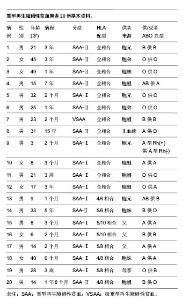| [1] Gupta V, Gordon-Smith EC, Cook G,et al.A third course of anti-thymocyte globulin in aplastic anaemia is only beneficial in previous responders.Br J Haematol. 2005;129(1):110-117.
[2] Brodsky RA, Jones RJ.Aplastic anaemia.Lancet. 2005;365 (9471):1647-1656.
[3] Eapen M.Allogeneic transplantation for aplastic anemia. Hematology. 2012;17 Suppl 1:S15-17.
[4] 张之南,沈悌.血液病诊断及疗效标准[M].3版.北京:科学出版社, 2007.
[5] Brümmendorf TH, Maciejewski JP, Mak J, et al. Telomere length in leukocyte subpopulations of patients with aplastic anemia. Blood. 2001;97(4):895-900.
[6] Yamaguchi H, Baerlocher GM, Lansdorp PM, et al. Mutations of the human telomerase RNA gene (TERC) in aplastic anemia and myelodysplastic syndrome. Blood. 2003;102(3): 916-918.
[7] Marsh JC, Ball SE, Cavenagh J, et al. Guidelines for the diagnosis and management of aplastic anaemia. Br J Haematol. 2009;147(1):43-70.
[8] Young NS, Scheinberg P, Calado RT. Aplastic anemia. Curr Opin Hematol. 2008;15(3):162-168.
[9] Frickhofen N, Heimpel H, Kaltwasser JP, et al. Antithymocyte globulin with or without cyclosporin A: 11-year follow-up of a randomized trial comparing treatments of aplastic anemia. Blood. 2003;101(4):1236-1242.
[10] Scheinberg P, Wu CO, Nunez O, et al. Long-term outcome of pediatric patients with severe aplastic anemia treated with antithymocyte globulin and cyclosporine. J Pediatr. 2008; 153(6):814-819.
[11] Bacigalupo A.Treatment strategies for patients with severe aplastic anemia.Bone Marrow Transplant. 2008;42 Suppl 1: S42-S44.
[12] Sun ZM, Liu HL, Geng LQ, et al. HLA-matched sibling transplantation with G-CSF mobilized PBSCs and BM decreases GVHD in adult patients with severe aplastic anemia.J Hematol Oncol. 2010;3:51.
[13] 朱玲,薛梅,王志东,等.异基因造血干细胞移植治疗重型再生障碍性贫血的疗效研究[J].中国全科医学,2011,14(17):1925-1927.
[14] 闫洪敏,刘静,薛梅,等.造血干细胞移植与非移植治疗重型再生障碍性贫血的比较[J]. 中国组织工程研究与临床康复,2011, 15(1):63-67.
[15] 闫蓓,曹永彬,高春记,等.联合脐血或脐带间充质干细胞异基因移植术后观察[J].军医进修学院学报,2010,31(7):658-659,701.
[16] 高力,刘嘉, 陈幸华,等. HLA不全相合造血干细胞联合脐血移植治疗急性白血病的临床观察[J].中国输血杂志,2012,25(2): 115-119.
[17] 龚奕,张曦,陈幸华,等.异基因造血干细胞移植治疗重型再生障碍性贫血临床研究[J].重庆医学,2010,39(14):1842-1845.
[18] Ahmed P, Chaudhry QU, Raza S,et al.Outcome of allogeneic haematopoietic stem cell transplantation in aplastic anaemia.J Coll Physicians Surg Pak. 2012;22(9):553-559.
[19] Socié G.Allogeneic BM transplantation for the treatment of aplastic anemia: current results and expanding donor possibilities.Hematology Am Soc Hematol Educ Program. 2013;2013:82-86.
[20] 齐薇薇,付蓉,王化泉,等.重型再生障碍性贫血患者外周血调节性T细胞的数量异常及其临床意义[J].中国实验血液学杂志, 2014, 22(4):1043-1046.
[21] Chan KW, Li CK, Worth LL,et al.A fludarabine-based conditioning regimen for severe aplastic anemia.Bone Marrow Transplant. 2001;27(2):125-128.
[22] 单秀山.再生障碍性贫血的治疗进展[J].海峡医学,2011,23(6): 217-218. |

